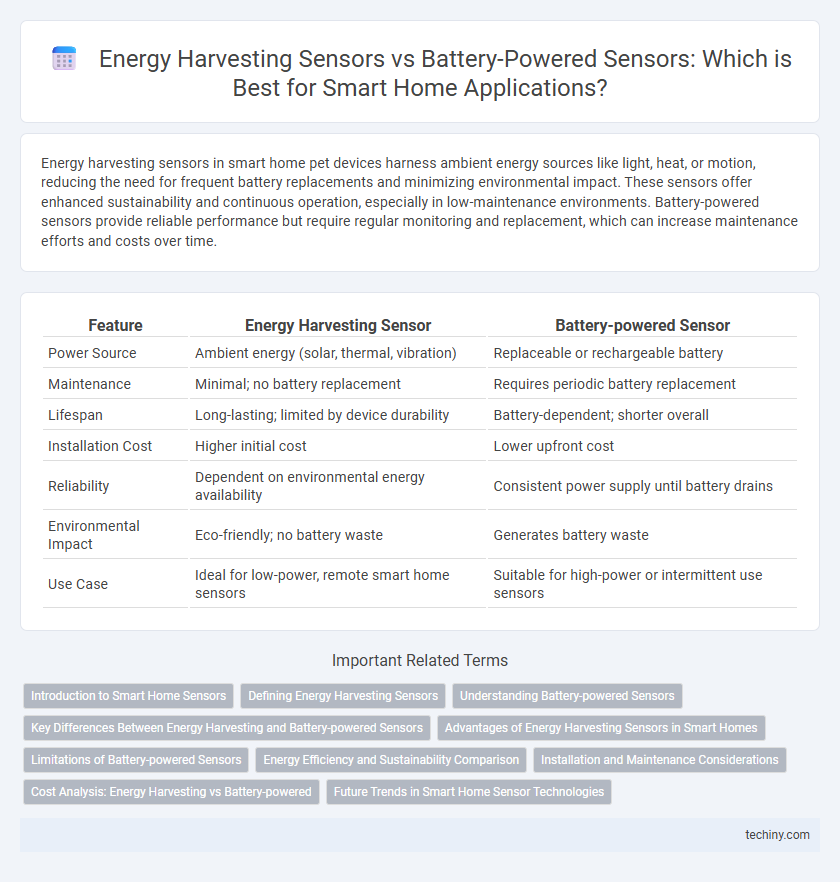Energy harvesting sensors in smart home pet devices harness ambient energy sources like light, heat, or motion, reducing the need for frequent battery replacements and minimizing environmental impact. These sensors offer enhanced sustainability and continuous operation, especially in low-maintenance environments. Battery-powered sensors provide reliable performance but require regular monitoring and replacement, which can increase maintenance efforts and costs over time.
Table of Comparison
| Feature | Energy Harvesting Sensor | Battery-powered Sensor |
|---|---|---|
| Power Source | Ambient energy (solar, thermal, vibration) | Replaceable or rechargeable battery |
| Maintenance | Minimal; no battery replacement | Requires periodic battery replacement |
| Lifespan | Long-lasting; limited by device durability | Battery-dependent; shorter overall |
| Installation Cost | Higher initial cost | Lower upfront cost |
| Reliability | Dependent on environmental energy availability | Consistent power supply until battery drains |
| Environmental Impact | Eco-friendly; no battery waste | Generates battery waste |
| Use Case | Ideal for low-power, remote smart home sensors | Suitable for high-power or intermittent use sensors |
Introduction to Smart Home Sensors
Energy harvesting sensors in smart homes utilize ambient energy sources like light, heat, or vibrations to power themselves, eliminating the need for batteries and reducing maintenance. In contrast, battery-powered sensors rely on replaceable or rechargeable batteries, which require periodic monitoring and replacement but often provide stable power output. Understanding the differences between these sensor types helps optimize smart home systems for energy efficiency and reliability.
Defining Energy Harvesting Sensors
Energy harvesting sensors convert ambient energy sources such as light, heat, or vibrations into electrical power, enabling continuous operation without external batteries. These sensors reduce maintenance costs and environmental impact by eliminating the need for frequent battery replacements. In smart home applications, energy harvesting sensors enhance system reliability and sustainability by leveraging renewable energy from the environment.
Understanding Battery-powered Sensors
Battery-powered sensors in smart home systems rely on chemical energy stored in batteries to operate, providing consistent power but requiring periodic replacement or recharging. These sensors offer reliable performance and high sensitivity, making them suitable for critical monitoring tasks where uninterrupted data transmission is essential. However, battery depletion and maintenance costs pose challenges compared to energy harvesting sensors, which draw power from environmental sources like light or vibration.
Key Differences Between Energy Harvesting and Battery-powered Sensors
Energy harvesting sensors generate power from ambient sources like light, heat, or vibrations, offering virtually unlimited operational life without the need for battery replacements, unlike battery-powered sensors that rely on finite chemical energy requiring periodic battery changes. Energy harvesting sensors provide enhanced sustainability and lower maintenance costs due to their self-sustaining power source, while battery-powered sensors can deliver more consistent power output and higher data transmission rates in short bursts. The choice between energy harvesting and battery-powered sensors depends on application demands, energy availability, and maintenance feasibility within smart home environments.
Advantages of Energy Harvesting Sensors in Smart Homes
Energy harvesting sensors in smart homes offer continuous, maintenance-free operation by converting ambient energy sources such as light, heat, and vibration into electrical power, eliminating the need for battery replacements. These sensors enhance sustainability by reducing electronic waste and lowering overall energy consumption, aligning with eco-friendly smart home initiatives. Their reliable, self-sufficient energy supply supports seamless integration with Internet of Things (IoT) devices, improving long-term performance and cost-efficiency compared to traditional battery-powered sensors.
Limitations of Battery-powered Sensors
Battery-powered sensors in smart homes often suffer from limited lifespan due to finite battery capacity, leading to frequent replacements and increased maintenance costs. Their reliance on batteries also poses environmental concerns and risks of power failure, compromising continuous operation and data reliability. In contrast, energy harvesting sensors leverage ambient energy sources, providing sustainable and maintenance-free functionality for long-term smart home performance.
Energy Efficiency and Sustainability Comparison
Energy harvesting sensors leverage ambient energy sources such as solar, thermal, or vibrational energy, significantly reducing the need for battery replacements and minimizing electronic waste in smart home systems. Battery-powered sensors, while reliable, require periodic maintenance and disposal, potentially contributing to environmental pollution and higher long-term operational costs. Integrating energy harvesting technology enhances sustainability by optimizing energy efficiency and promoting eco-friendly smart home solutions.
Installation and Maintenance Considerations
Energy harvesting sensors require no battery replacement, reducing maintenance efforts and costs compared to battery-powered sensors that need periodic battery changes. Installation of energy harvesting sensors is often simpler since they eliminate concerns about battery access and disposal, enabling more flexible placement in smart home environments. Battery-powered sensors may face interruptions if batteries deplete, whereas energy harvesting sensors provide consistent, long-term operation by converting ambient energy sources.
Cost Analysis: Energy Harvesting vs Battery-powered
Energy harvesting sensors eliminate ongoing battery replacement costs by converting ambient energy sources such as solar, thermal, or vibrational energy into usable power, resulting in lower maintenance expenses over time. Battery-powered sensors typically incur higher operational costs due to periodic battery procurement, disposal, and labor for replacement, which can increase total cost of ownership in large-scale smart home deployments. Initial installation expenses may be higher for energy harvesting systems due to advanced technology, but the reduction in lifecycle costs often makes them more economical in the long term.
Future Trends in Smart Home Sensor Technologies
Energy harvesting sensors in smart homes leverage ambient energy sources such as solar, thermal, and kinetic power, enabling maintenance-free operation and reducing environmental impact compared to traditional battery-powered sensors. Advances in nanotechnology and ultra-low power electronics are driving future trends toward fully autonomous sensor networks that integrate energy harvesting capabilities for continuous monitoring and smart automation. This shift enhances sensor longevity, scalability, and cost efficiency, crucial for the growing Internet of Things (IoT) ecosystem in residential environments.
Energy Harvesting Sensor vs Battery-powered Sensor Infographic

 techiny.com
techiny.com